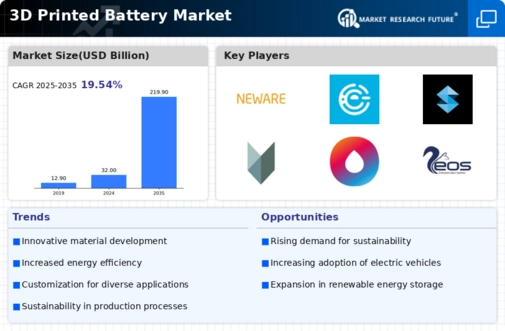Rising demand for 3D printed batteries from major end-use industries to fuel the 3D Printed Battery market
The rising demand for 3d printed batteries from major end-use industries is one of the major factors driving the growth of the 3d printed battery market. The expansion of the 3D printing market is anticipated to be fueled by the rise in demand for 3D printed items in the automotive, healthcare, and aerospace & defence sectors. The need for 3d printed batteries is rising as 3d printing technology is being adopted more widely in the automotive and aerospace sectors. Electric and hybrid electric vehicles both use these batteries.
Another element fueling the expansion of the market for 3D printed batteries is the growing demand for electric vehicles. The market for 3D printed batteries is expanding as a result of the rising demand for consumer devices.
The end-use market for 3D printed batteries with one of the quickest growth is the automotive sector. Due to its numerous advantages, including decreased manufacturing costs, time, and product weight, the automotive industry is turning away from conventional manufacturing techniques and towards 3D printing. This is a result of the growing demand for electric cars (EVs) and the requirement for battery miniaturisation. In order to lighten and extend the range of electric vehicles, 3D printed batteries are used. Both plug-in hybrid electric cars (PHEVs) and hybrid electric vehicles (HEVs) use these batteries.
Additionally, the automotive sector is spending a lot of money on 3D printing research and development. For instance, the BMW Group declared in January 2019 that it would spend EUR 10 million on its 3D printing campus in Munich, Germany. This facility would be utilised to create innovative 3D printing technologies for small-batch production and rapid prototyping.
The consumer electronics industry is also one of the fastest growing end-use industry for 3D printed batteries. Due to the necessity for battery miniaturisation, the consumer electronics industry is seeing an increase in demand for 3D printed batteries. These batteries are utilised in wearable electronics, computers, and portable electronic gadgets. Compared to conventional batteries, 3D printed batteries have a better energy density and can be made to fit a specific device's needs.
Leading electronic companies are implementing 3D printing technologies to produce printed cells (microbattery) suitable with smart devices that have a low volumetric expansion, high-rate capability, stability, and security, which is anticipated to boost the market in the upcoming years. A 3D battery printing business called Sakuu Corporation has made progress in the development of its lithium-ion battery by obtaining an energy density of 800 Wh/L. The outcome, according to the business, is a significant advancement on its roadmap towards a fully functional 3D printed solid-state battery (SSB) capable of more than 1,200 Wh/L by 2023.
This would be far better than the lithium-ion battery that currently dominates the market and works in the 500–700 Wh/L range. In order to stay competitive in the market, major players in the global 3D printed battery business are quickly creating batteries using 3D printers and 3D printing technologies. Leading makers of 3D printed batteries are working with companies that make cars and aeroplanes to advance the market for these batteries. These batteries can reduce production costs, supplementary material costs, and current collector energy use by roughly 30%.
Manufacturing 3D-printed batteries has the potential to reduce capital costs by 40% when compared to the conventional battery manufacturing process.
The healthcare industry is also expected to boost the progress of the 3D printing market. The usage of 3D printing in the healthcare sector is anticipated to rise as a result of its capacity to produce personalised implants and prosthetics that conform to the anatomy of the patient. Additionally, a demand for 3D-printable organs is anticipated due to the rise in organ transplantation procedures. For instance, in the United States, a patient received the first kidney transplant made via 3D printing in 2016.
Additionally, the aerospace and defence sector is another important market for 3D printing. 3D printing is being used by the aerospace and defence sector to create prototypes and produce small batches of parts. The usage of 3D printing in the aerospace and defence sector helps with a major difficulty encountered by the sector: lowering the weight of the final goods. For instance, the Airbus Group declared in 2016 that by 2025, it will employ 3D printing to make up to 1,000 metal parts for each aircraft.
Additionally, conventional batteries don't match characteristics like flexibility, dependability, thinness, or lightweightness; as a result, wearable technology has grown to be a significant business for the market for 3D printed batteries. A recent study estimates that the worldwide wearables market will generate about $15,376 million in sales in 2020, with 356.8 million active users. Therefore, it is anticipated that all of these key industries, which are themselves growing exponentially, would eventually help to expand the global market for 3D printed batteries.
The integration of additive manufacturing technologies in battery production appears to enhance customization and efficiency, potentially revolutionizing energy storage solutions.
U.S. Department of Energy







